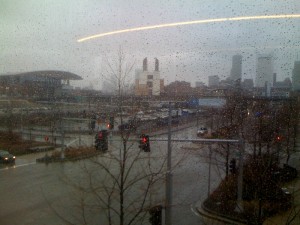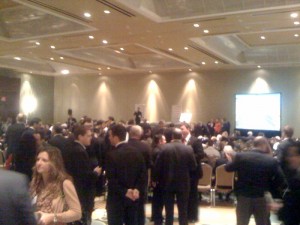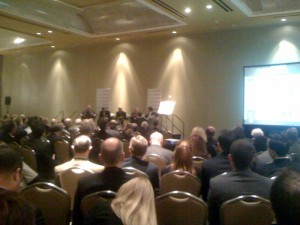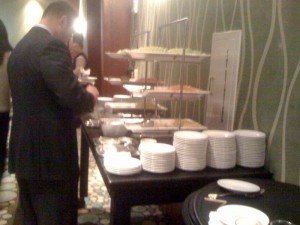It was a dark and stormy…day, in Boston’s Seaport District. Also known as the Innovation District.
 You can see the hulking roof of the Boston Convention Center on theleft, the towers of International Place and theFederal Reserve on the right. The foreboding figure in the center is an exhaust structure from the Ted Williams Tunnel. And surrounding, the many parking lots. All this will be re-developed in the coming years. More to be seen to the right of the photo – the Fallon Company’s Seaport Square project. More on that in another post.
You can see the hulking roof of the Boston Convention Center on theleft, the towers of International Place and theFederal Reserve on the right. The foreboding figure in the center is an exhaust structure from the Ted Williams Tunnel. And surrounding, the many parking lots. All this will be re-developed in the coming years. More to be seen to the right of the photo – the Fallon Company’s Seaport Square project. More on that in another post.
 Real Estate BisNow put together a great show about apartment complexes this morning. Many players in the multifamily development industry came together. There were two panels: one on developers and one on owners. Developers included WinnDevelopment’s Larry Curtis who mentioned how they build the $2/sf/mo rental for regular people, not the $4/sf/mo like Avalon Bay and Equity Residential (both represented). Simon Butler of CBRE noted it costs $400/sf to build institutional (pension fund and REIT) quality apartment complexes, and that is getting hard to do in the Boston area. The speakers agreed that the constrained development market is good but the extremely low cap rates, 4% these days, are too low to handle long-term management/cap improvement needs. Some projects are going to be built as inventory for other owners in the future, said Larry Curtis.
Real Estate BisNow put together a great show about apartment complexes this morning. Many players in the multifamily development industry came together. There were two panels: one on developers and one on owners. Developers included WinnDevelopment’s Larry Curtis who mentioned how they build the $2/sf/mo rental for regular people, not the $4/sf/mo like Avalon Bay and Equity Residential (both represented). Simon Butler of CBRE noted it costs $400/sf to build institutional (pension fund and REIT) quality apartment complexes, and that is getting hard to do in the Boston area. The speakers agreed that the constrained development market is good but the extremely low cap rates, 4% these days, are too low to handle long-term management/cap improvement needs. Some projects are going to be built as inventory for other owners in the future, said Larry Curtis.
 The Owner panel included Bobby Zucker of Chestnut Hill Realty, Bill McLaughlin of Avalon Bay, Bruce Percelay of the Mount Vernon Company and the legendary Harold Brown at the Hamilton Companies. Home ownership is at a 66% rate now, over the historical 64%, and Bill McLaughlin believes that will decrease and decrease. Millennials want urban living, and many people are realizing renting is not bad – plenty in Europe do this for generations. Harold Brown wanted everyone to be careful – three years ago he said it was time to invest in multifamily, and now it’s getting pretty hot if you’re not already there. As the business cycle comes back, cap rates will increase, and developers will lose buildings. Bruce Percelay noted that Boston is a hot market benefiting from wholesale cheap money, a raging bull market in a sluggish national economy that keeps the rates low. Bobby Zucker mentioned that because there are so many demand drivers, it is still a good market to put money into, those drivers aren’t going away soon. He also mentioned there are a lot of technical improvements in property management and leasing that improve his organization’s profitability.
The Owner panel included Bobby Zucker of Chestnut Hill Realty, Bill McLaughlin of Avalon Bay, Bruce Percelay of the Mount Vernon Company and the legendary Harold Brown at the Hamilton Companies. Home ownership is at a 66% rate now, over the historical 64%, and Bill McLaughlin believes that will decrease and decrease. Millennials want urban living, and many people are realizing renting is not bad – plenty in Europe do this for generations. Harold Brown wanted everyone to be careful – three years ago he said it was time to invest in multifamily, and now it’s getting pretty hot if you’re not already there. As the business cycle comes back, cap rates will increase, and developers will lose buildings. Bruce Percelay noted that Boston is a hot market benefiting from wholesale cheap money, a raging bull market in a sluggish national economy that keeps the rates low. Bobby Zucker mentioned that because there are so many demand drivers, it is still a good market to put money into, those drivers aren’t going away soon. He also mentioned there are a lot of technical improvements in property management and leasing that improve his organization’s profitability.
Bruce Percelay described how the new product they are putting onto the market is superior to so much of the stock in Boston – you just can’t improve a lot of old buildings to today’s demand. Harold Brown mentioned they don’t use “OPM” – Other People’s Money – so they have more room to be creative, but cautiously. When Bruce suggested his projects will have unique features tenants want, Harold quipped “views?” and Bruce quickly responded: “Ours will actually have windows” – to which the crowd had a tremendous chuckle considering the reputation the Hamilton Co. has for low-grade apartments. “Well said” retorted the still-quick at 84 Brown.
 All in all it was a great meeting, and I learned a lot. I caught a few people to talk about green leasing and some were interested, some still trying to resist, claiming it costs more. I explained the benefits outweigh the costs if you look at the whole picture of aligning your space with your brand, if you’re trying to attract and retain the best talent, and if you are serious about saving operating costs. I made some good connections and had my daily portion of fruit from the buffet! I’ll keep you posted about my next excursion into Boston’s Real Estate world with BisNow. Let me know if you plan to attend one and we can meet up!
All in all it was a great meeting, and I learned a lot. I caught a few people to talk about green leasing and some were interested, some still trying to resist, claiming it costs more. I explained the benefits outweigh the costs if you look at the whole picture of aligning your space with your brand, if you’re trying to attract and retain the best talent, and if you are serious about saving operating costs. I made some good connections and had my daily portion of fruit from the buffet! I’ll keep you posted about my next excursion into Boston’s Real Estate world with BisNow. Let me know if you plan to attend one and we can meet up!
